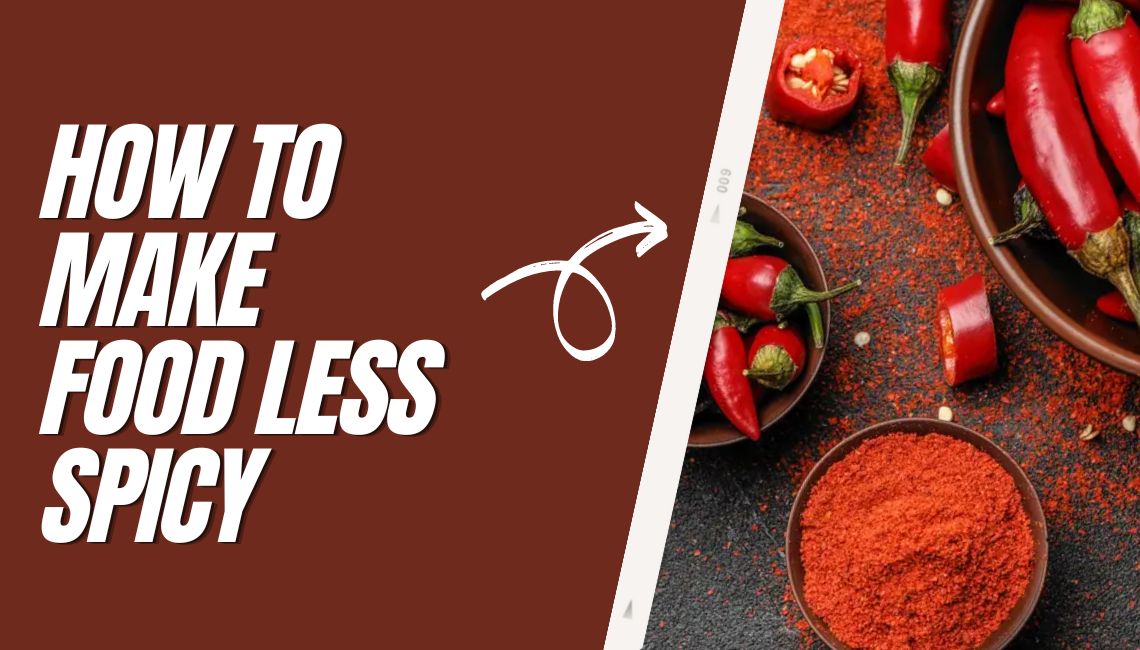
Introduction
In this article we are going to share How To Make Food Less Spicy. So many people enjoy a little spiciness in some meals, particularly Mexican and Cajun fare. The heat supplied by chili peppers, jalapenos, and other condiments can enhance a dish that is otherwise average and make it more exciting.
Some are also lovers of surprise spiciness, adding a small amount of spiciness into dishes where you wouldn’t anticipate it to, breeds a bit of curiosity. We must be aware that there is always the potential of over spicing food. If you’re not used to eating spicy dishes, it may not require much heat to turn the cuisine into something you don’t want to eat.
If you are unfamiliar with cooking using hot peppers as well as other spicy seasonings, it’s indeed easy to overdo and not realize it until you bite into the meal. That is such an unexpected feeling. Once you’ve gotten used to cooking with chili ingredients, you’ll be able to judge how much should be in a meal and regulate it better, but before then, you might make some unappealing blunders.
There’s also the issue of cooking hot meals for others. Each individual has a different tolerance for heat, and you might not always know what that is. How can I make food less hot for my guests and family? How may the spiciness be reduced so that the cuisine is pleasant and enjoyable? There’s a chance you’ll ruin the flavor and overpower your cuisine with spice. Obviously there is a solution, but how can you make food less spicy?
In this post, we will discuss a few strategies for controlling the heat in already prepared foods. These are tried-and-true ways that anyone can utilize, and we will provide you with a wide range of heat management options so that you can manage the spiciness in any food.
How To Make Food Less Spicy
Get a good partnering dish
The simplest methods are frequently the most successful, and the simplest approach to cope with spicy food without diminishing the flavor or ruining the dish as well as its carefully selected ingredients is to select the appropriate side dishes to accompany it.
So, if you have a spicy food that really is overly picante, you can regulate it by serving it with a bland or starchy dish as a side. This balances out the spiciness, so you can enjoy the two together since the side dish manages the overbearing spiciness in a good way.
This is why chips come with salsa and hot burritos come with a bland tortilla shell. These are pre-programmed responses to the spiciness of a few of the components, thus you can do this with your own meals.
Breads, tubers, ginseng veggies, and pasta are excellent for diluting spiciness whenever served as a side dish. If you discover that your main meal is too spicy, get one of these sides to help you manage with the heat.
Increase the Amount of Ingredients
Another easy approach to make a dish less spicy without affecting the flavor too much is to use more non-hot components. For many chefs, this is their preferred method on how to make food less spicy. So, if your chili soup is too hot and spicy, simply add extra of the non-spicy components, such as ground beef, legumes, and even water.
Avoid including just so many bland items in your dish. You can ruin the flavor by diluting the spiciness, so keep an eye on the flavor balance. Keep in mind that you are not aiming to erase the flavor of the food, but rather to reduce the spiciness. There is a distinction, and you must be mindful of how the many flavors in your cuisine interact with and balance each other.
Add Some Dairy Products

If you are curious and you ask a question about how to make food less spicy without introducing more food, then this answers your question. The introduction of dairy to overly hot meals is not only a common choice, but it is also supported by science. Casein, a protein found in milk, binds to the chemical behind the spiciness in red peppers (capsaicin). Because of the affinity amongst casein and capsaicin, the former separates from the synapses on the tongue and is readily rinsed away.
Add a Few Acidic Flavors

Acids are commonly used as tools to tone down spicy food. Since capsaicin has a high pH and is alkaline, it must be neutralized with an acid. Adding some acidic components will counteract heat to some extent, but it is unlikely to make a significant effect in excessively spicy food.
Many cuisines demand for acid to offset spicy jalapeno as well as other spicy foods, particularly Thai dishes, which use lime and some other types of citrus to try to cover up the dish’s very fiery chilis. You have the same option. Introducing some lemon and lime juice, or any acidic beverage to the cuisine can help to reduce the spiciness. This can render the dish more appetizing while also adding flavor, so it’s a well-balanced situation if you understand what you’re doing.
Ketchup is a versatile acid that may be used in a variety of meals. This is extremely beneficial for providing mildly spicy foods to children. They don’t usually like spicy cuisine, but they do prefer ketchup. So, smothering food that is just too peppery for a child in ketchup is an easy option. This might be a lot more convenient and simple than preparing separate meals for children and adults. Understanding how much you can add to reduce the spiciness would save you time and help you achieve a degree of spiciness with which you can manage.
Add Sugar
Adding sweetness to an already hot dish is a common solution on how to make food less savoury, however, it will not function well with several dishes. The sweetness will balance the meal and partially mitigate the spice, but too much of it will toss off the savoury culinary character. It works best with dishes that are just a tad too hot.
The concern in using sweetener to lessen spiciness is that it might make your cuisine overly sweet and syrupy. If you don’t want the meal to become a dessert, use a small amount of sugar. You likely won’t need much more sweetener to tame the spiciness, so start with a small amount and test it before adding more.
Add Peanut Butter

Capsaicin, a hydrophobic, lardy molecule, makes food hot and it absorbs fat and oil rather than water. As a result, while milk is a well-known choice for balancing spice, peanut butter is also another pantry essential which can be just as efficient. It is a lactose-free, organic remedy for heat.
Peanut creams will not function in every spicy meal, though they will in many. If you have peanut butters, try them in savoury dishes like sauces, soups, and stew. They will not only aid to cool the spiciness, but they’ll also be unnoticeable to the whole flavor.
If the Meal Is Too Spicy in Your Mouth, This Will Relieve It.
If it’s too late and the meal is already scorching your mouth, there are several options for cooling down. There have been studies conducted to determine which substances can alleviate the burning feeling. Some of them are listed here.
Casein
Casein, a protein present in milk and dairy, dissolves the harsh alkaloid capsaicin. It’s worth noting that vegan milk replacements normally don’t include casein, but there’s no excuse not to go vegan.
Consider casein to be a soap, collecting, enveloping, and assisting to scrub away those oil-based chilli particles swirling throughout your mouth in the same manner that soap does. The caveat is that the dairy product you chose must include casein in order to chill your mouth. Animal milk (not other natural milk like almond, coconut, or soy), curd, cream cheese, and sour cream are examples of casein-containing milk products.
Fat
As stated earlier, fat is one of the solutions for how to make food less spicy, but this time, in your mouth. Capsaicin is a fat-soluble compound. Products having a high amount of fat, such as dairy, butter, or yogurt, can help minimize the heat even if you’re still preparing or consuming. An Indian fruit lassi or a refreshing cup of buttermilk go well with spicy meals.
Oil is also beneficial: Simply wash your mouth with a spoonful of oil or a combination of oil and water. However, be cautious and avoid drinking only water as this will increase the heat and disperse the capsaicin inside your mouth.
Bread and Carbs
Starch granules are satisfying for a variety of reasons, one being that they often have a high physical content. When eating spicy dishes, the quantity provided by a starchy meal can sometimes be useful since it can act as a buffer barrier between both the capsaicin and your mouth. Try eating a slice of bread, grains, or a tortilla to place some carbohydrate between this deceptive chemical and your pain sensors.
Acidic Drinks or Food
Don’t be concerned if you want or need to avoid dairy. You have another choice as well: acid. Capsaicin is an alkaline chemical, as we already stated. The activity of the molecule can be neutralized by neutralizing it with an acid. This implies that sipping or consuming something acidic, such as lemonade, limeade, citrus fruits, or a tomato-based meal or liquid, may also aid in cooling your tongue. (Milk also is acidic.)
What Not To Take
Water
Do not believe that a cup of water will save you. If you remember nothing else, remember this: Because capsaicin is an oil, drinking water will essentially simply distribute this molecule throughout your mouth, activating more and more of your sensory nerves.Rather than a glass of water, consider one of the alternatives listed above about how to make food less spicy.
Alcohol
Do not expect alcohol to eliminate the pain. You’ve seen old war films. One soldier sprays alcohol on an open wound to sterilize it before sealing it. The injured soldier then chugs whatever remains in the flask. For a long time, people have used alcohol to relieve pain.
However, keep in mind that the amount of alcohol required to successfully alleviate pain far surpasses the standards for moderate alcohol consumption. Furthermore, many alcoholic beverages contain more water than alcohol.
How To Avoid Making Your Meal Too Spicy
What can you do to keep your food from getting excessively spicy in the first place or how do you tone down spicy food? Find out below:
- Season gradually and taste frequently, especially when using extremely hot spices.
- If you mistakenly added too much spice, attempt to remove as much as possible before churning.
- Rather than chopped, dried, or crushed chillies, use whole ones. This way, you can let the pods simmer for a few minutes before removing them.
- Discard the white rind and seeds from the jalapenos before chopping them.
- If you’re using canned chiles, rinse the pods first.
- Examine the spices you’re using! You’ll realize how these taste and also how spicy they are, as well as how much to use.
- Serve flatbread or grains, as well as a dairy beverage with spicy cuisine.
What Not To Do
Let us round up this article with a warning about some things you should not do if you want to learn how to make food less spicy or how to tone down spicy food, let’s say your breakfast sausage. Certain items can help to increase the chilli of a dish.
One of these is a hot beverage. If you drink hot chocolate, coffee, or tea alongside your meal, the spiciness can intensify. Not sure whether you’ve ever observed this, but it’s something to keep an eye out for.
If you are consuming anything spicy and thus are worried about it being too spicy, sip anything chilled or at ambient temperature with it. Consuming anything hot will intensify and exacerbate the spiciness, so avoid drinking something hot with a dish which is already too spicy for you.
Conclusion
Capsaicin is the molecular ingredient that gives spicy foods their spicy flavor. Peppers contain the maximum concentration, with the seeds having the highest density. Whenever you consume capsaicin, the chemical binds to the receptors on your tongue which sense temperature fluctuations and discomfort, resulting in the characteristic burn.
Several people are more sensitive to capsaicin than the others, but you may gradually condition yourself to endure the pain. Of course, some folks simply love spicy cuisine in general. If you’re training your palate, keep a jar of peanut butter, a glass of acidic drink, or a glass of milk or yogurt on hand, for spice emergencies.
FAQs
Q. Is Spicy Food Good for the Body?
Ans. Yes. Spices may benefit heart health by aiding in the digestion of lipids in diets. According to several studies, spicy foods may lower the risk of conditions such as hypertension, high cholesterol, and adult-onset diabetes.
Q. Can Spicy Food Burn Fat?
Ans. Yes. Studies have revealed that spicy foods can aid in the battle against obesity by cutting calorie consumption, reducing body fat tissue, decreasing cholesterol and triglyceride levels, and fighting fat formation by inducing favorable protein modifications in the body.
Q. Is Spicy Food Addictive?
Ans. Chili peppers do not have addictive characteristics, yet the sensation of heat and agony causes the production of pleasurable endorphins.
Read our another blogs.
VLM STAFF
Chloe Blake
Senior News Writer at Voice Life Media
Howdy, I'm Chloé Blake, a writer, and a little bit multimedia content creator.I run "Voice Life M...




